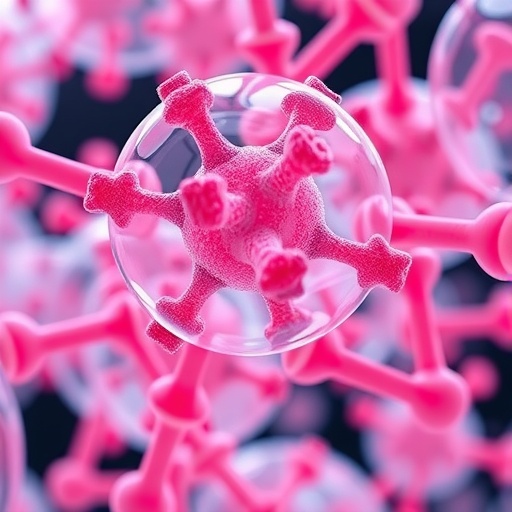In the relentless struggle against antibiotic resistance, scientists often face the daunting challenge of discovering new antimicrobial compounds that can outpace evolving pathogens. A groundbreaking study published in Nature Biotechnology this year promises to revolutionize this search by harnessing the power of deep learning, dramatically accelerating how novel antibiotic scaffolds are identified. The work led by Zhang, Song, and de la Fuente-Nunez presents an innovative computational platform that integrates cutting-edge artificial intelligence with traditional drug discovery workflows, offering a beacon of hope in an ever-worsening global healthcare crisis.
For decades, the antibiotic discovery pipeline has remained painfully sluggish, often constrained by time-consuming experimental methods laden with high failure rates. Traditional approaches rely heavily on screening vast chemical libraries through labor-intensive assays, frequently resulting in rediscovery of known compounds rather than novel chemotypes. This bottleneck has compounded the peril posed by multidrug-resistant organisms, which threaten to render many existing treatments obsolete. In this context, deep learning—the subset of machine learning algorithms modeled loosely on neural networks in the brain—has emerged as a transformative technology capable of parsing massive, complex datasets to discern intricate patterns invisible to human screening.
The innovation detailed by Zhang and colleagues involves designing deep neural networks that predict antimicrobial activity at the molecular scaffold level. Traditionally, antibiotic drug discovery focuses on entire molecules, but this approach targets the core chemical frameworks—the scaffolds—that underpin functional compounds. By training models on comprehensive datasets of known antibiotics and their molecular structures, the system learns to infer which scaffolds are most likely to yield effective antimicrobial agents. This scaffold-centric perspective advances the search beyond incremental modifications, unlocking previously unexplored chemical spaces with untapped therapeutic potential.
An essential feature of the platform is its multi-tiered architecture, combining graph-based neural networks with generative adversarial networks (GANs). The initial stage involves encoding chemical structures as graphs, representing atoms as nodes and bonds as edges, allowing the model to capture spatial and electronic characteristics crucial for bioactivity. Subsequently, the GAN component generates novel scaffold candidates, iteratively refined based on predicted antimicrobial efficacy. This marriage of graph representation and generative modeling empowers the system to propose entirely new chemical frameworks rather than simply tweaking known antibiotics, embodying a paradigm shift in de novo drug design.
The results delivered by this AI-driven approach are staggering. Within a fraction of the time required by conventional high-throughput screens, Zhang’s platform identified dozens of previously unreported scaffolds exhibiting potent antibacterial activity across multiple strains, including notorious multidrug-resistant pathogens such as methicillin-resistant Staphylococcus aureus (MRSA) and carbapenem-resistant Enterobacteriaceae. In vitro assays confirmed that a subset of these AI-predicted scaffolds not only inhibited bacterial growth effectively but also demonstrated favorable pharmacokinetic properties, underscoring their potential as lead drug candidates.
What sets this methodology apart is its adaptability and scalability. Unlike prior computational tools limited by narrow training sets or rigid molecular assumptions, this deep learning framework can continually incorporate new data, learning from experimental feedback to improve its predictive accuracy in real time. This dynamic learning loop accelerates iterations between virtual screening and bench validation, forming an unprecedented synergistic cycle where AI and human expertise coalesce to optimize drug discovery pathways.
Deep learning also mitigates one of the most persistent hurdles—chemical novelty. By focusing on scaffold innovation, the model circumvents the redundancy typical in antibiotic libraries burdened by intellectual property constraints and structural similarities. This opens the door to a broader spectrum of molecular entities, some occupying underexplored regions of chemical space. The implications are profound: new antibiotics discovered through this pipeline may possess mechanisms of action distinct from existing drugs, potentially evading resistance mechanisms that have already compromised conventional treatments.
Moreover, the study thoughtfully addresses potential pitfalls of AI in drug discovery, such as model interpretability and the risk of overfitting. The researchers employ explainable AI techniques that provide insights into the molecular features driving predictions, enhancing trust and guiding medicinal chemists in rational design. Robust validation strategies, including cross-dataset evaluations and prospective experimental testing, ensure that the AI-generated scaffolds translate into tangible biological activity rather than artifacts of computational bias.
From a broader perspective, Zhang and colleagues’ work exemplifies the maturing confluence of biotechnology and artificial intelligence. The rapid evolution of computational frameworks and molecular databases creates fertile ground for AI to accelerate pharmaceutical innovation, potentially transforming not only antibiotics but also therapeutics for cancer, neurodegeneration, and rare diseases. Their study serves as a compelling template for future efforts aiming to harness data-driven approaches alongside experimental science to meet urgent biomedical challenges.
Despite the promising results, the authors acknowledge that clinical translation remains a complex journey. Rigorous preclinical and clinical testing are essential to ensure safety, efficacy, and regulatory approval. However, by greatly expanding the repertoire of candidate molecules and compressing the timeline for initial discovery phases, this AI-empowered platform promises to tip the scales in favor of timely, effective antibiotic development, an urgent need as global antimicrobial resistance escalates.
The integration of deep learning into antibiotic discovery aligns with a growing recognition that future breakthroughs will require interdisciplinary synergy. Chemists, microbiologists, computer scientists, and clinicians must collaborate seamlessly to translate AI-generated hypotheses into viable medicines. The study’s open-source framework and comprehensive data sharing ethos aim to foster such collaborations, catalyzing an ecosystem of innovation unparalleled in the history of drug discovery.
In summary, this pioneering research heralds a new dawn for antimicrobial development, where artificial intelligence accelerates and expands the search for life-saving drugs amid an intensifying health crisis. By leveraging deep neural networks to identify novel antibiotic scaffolds rapidly, Zhang, Song, and de la Fuente-Nunez illuminate a path towards replenishing our dwindling antibiotic arsenal. Their approach exemplifies how modern computational tools can meet one of medicine’s most pressing challenges, rekindling hope for a future in which bacterial infections are once again controllable and treatable.
The impact of this advancement cannot be overstated. As antibiotic resistance threatens to erode decades of medical progress, innovative strategies such as deep learning-enabled scaffold discovery are imperative. This approach not only expedites the identification of new drug candidates but also enriches the diversity of chemical entities entering the development pipeline, increasing the likelihood of clinical success. The scientific community eagerly anticipates how this technology will evolve and integrate into broader drug discovery paradigms.
Furthermore, the study’s emphasis on scaffold-based design offers conceptual clarity and practical advantages. By dissecting antimicrobial activity to its chemical core components, the model’s insights allow researchers to better understand structure-activity relationships. This knowledge can inform targeted medicinal chemistry efforts to enhance efficacy and reduce toxicity, customizing antibiotics for specific clinical needs. The strategy thus contributes not only compounds but also deeper mechanistic understanding of antimicrobial action.
As these AI technologies mature, ethical considerations and regulatory frameworks will also need to adapt to guide their application responsibly. Ensuring transparency, reproducibility, and accountability in AI-driven drug discovery is crucial to maintain public trust and scientific rigor. Zhang and colleagues’ transparent methodology and rigorous validation provide an encouraging precedent, demonstrating that AI can be integrated thoughtfully into biomedical research.
The melding of artificial intelligence with antibiotic discovery epitomizes the transformative potential of modern science. By unleashing deep learning to unveil new antibiotic scaffolds, this groundbreaking work charts a bold course toward overcoming one of the 21st century’s most critical health threats. It stands as a testament to human ingenuity and the extraordinary possibilities unlocked through interdisciplinary collaboration and technological innovation.
As the global scientific community continues to grapple with antibiotic resistance, the integration of AI-powered scaffold discovery is poised to become an indispensable tool. The startling efficiency and creativity of the model in identifying viable scaffolds foreshadow a broader revolution in drug development, where machine learning augments human intuition and accelerates breakthroughs. Ultimately, this approach promises to restore hope in our fight against deadly infections and safeguard global public health for generations to come.
Subject of Research: Antibiotic discovery using deep learning-based scaffold identification.
Article Title: Deep learning speeds the search for new antibiotic scaffolds.
Article References:
Zhang, Y., Song, J. & de la Fuente-Nunez, C. Deep learning speeds the search for new antibiotic scaffolds. Nat Biotechnol (2025). https://doi.org/10.1038/s41587-025-02806-6
Image Credits: AI Generated
Tags: accelerating drug discovery processesartificial intelligence in drug developmentcomputational platforms for drug discoverydeep learning in antibiotic discoveryenhancing antimicrobial compound screeninginnovative approaches to antibiotic researchmachine learning in healthcaremultidrug-resistant organisms solutionsnovel antibiotic scaffolds identificationovercoming antibiotic resistancetechnological advancements in healthcaretraditional vs modern drug discovery





